Creating an outdoor TV cabinet is a practical and stylish way to enjoy entertainment in your backyard, patio, or garden. Whether you want to host a movie night under the stars or catch your favorite sports game while grilling, a sturdy and weather-resistant cabinet will protect your TV from the elements and ensure a seamless viewing experience.
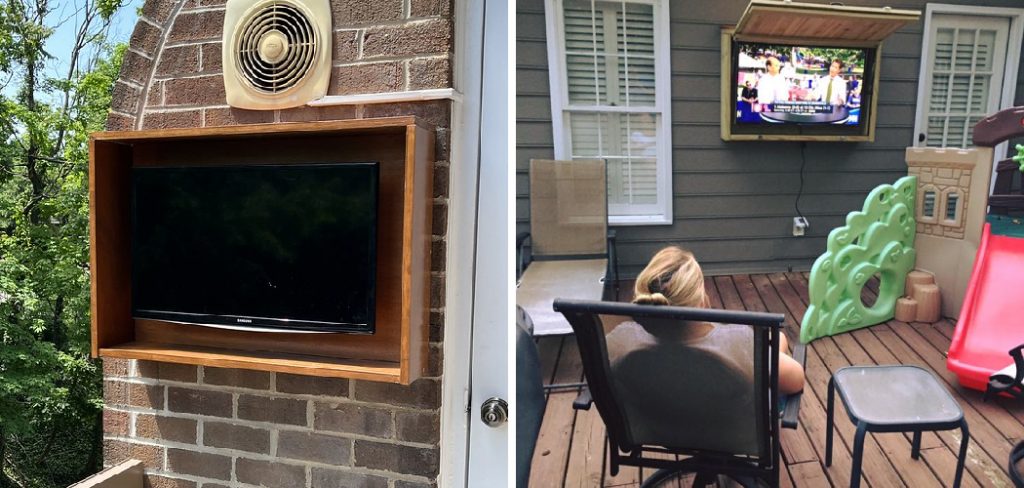
Understanding how to build an outdoor tv cabinet can help in maintaining it properly and troubleshooting common issues that may arise over time.
Why Build an Outdoor TV Cabinet
Building an outdoor TV cabinet provides several key benefits that enhance both functionality and aesthetics. Firstly, it offers protection from harsh environmental elements such as rain, snow, humidity, and UV rays, ensuring your TV remains in good condition for years. Additionally, a well-designed cabinet adds an attractive feature to your outdoor living space, blending seamlessly with your existing décor.
It also provides security by concealing your TV when not in use, reducing the risk of theft or damage. For those who love entertaining outdoors, an outdoor TV cabinet creates a cozy and inviting setup, making your patio or backyard the perfect spot for gatherings, whether it’s a casual barbecue or a festive game night.
Tools and Materials Required
Before starting your outdoor TV cabinet project, it’s important to gather all the necessary tools and materials to ensure a smooth building process. Here’s a comprehensive list of what you’ll need:
Tools:
- Measuring tape
- Power drill and bits
- Circular saw or jigsaw
- Screwdriver
- Clamps
- Hammer
- Sandpaper or an electric sander
- Paintbrush or foam roller
Materials:
- Outdoor-grade plywood or weather-resistant wood (e.g., cedar, teak, or pressure-treated wood)
- Stainless steel or galvanized screws and hinges
- Silicone or weatherproof sealant
- Outdoor waterproof paint or wood stain
- Weatherstripping
- L-brackets for support
- Plexiglass or tempered glass (optional, for additional screen protection)
- Cabinet handles or knobs
- Mounting brackets (if mounting to a wall or structure)
Having all these tools and materials ready will streamline the process and ensure your outdoor TV cabinet is both durable and attractive.
10 Methods How to Build an Outdoor Tv Cabinet
1. Planning and Designing the Cabinet
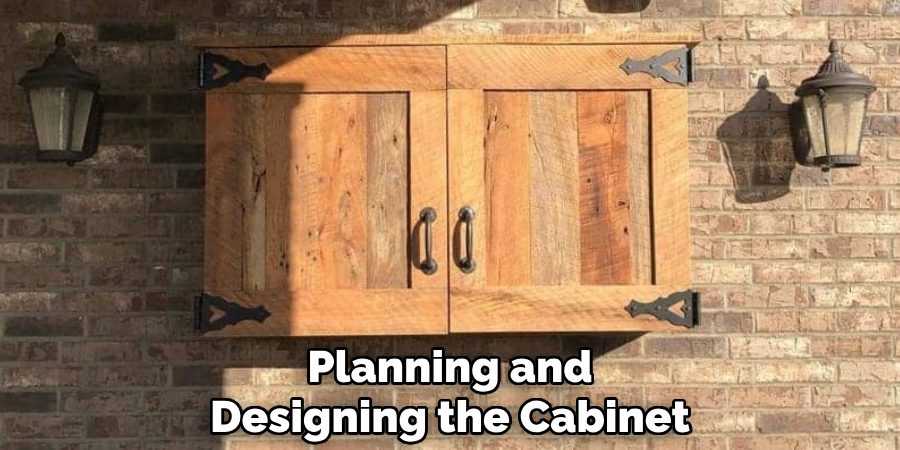
Before starting construction, you need a clear design plan. Consider the size of your TV, the space where the cabinet will be installed, and any additional features you want, such as shelves for media devices or ventilation slots. Measure your TV’s dimensions, ensuring that the cabinet allows enough clearance for air circulation and easy access to ports.
Sketch a blueprint, specifying the materials you’ll use and the method of securing the cabinet to a wall or stand. A well-planned design prevents mistakes and ensures a seamless building process.
2. Choosing Weather-Resistant Materials
Since the cabinet will be exposed to outdoor conditions, selecting weather-resistant materials is crucial. Use pressure-treated wood, marine-grade plywood, or composite materials that can withstand moisture and temperature changes. For added durability, consider PVC boards, which are rot-proof and require minimal maintenance. If using metal hardware, opt for stainless steel or galvanized screws and hinges to prevent rust. Choosing the right materials ensures that your cabinet remains sturdy and functional for years.
3. Building a Sturdy Frame
The frame serves as the foundation of your TV cabinet and must be strong enough to support the structure and the television. Construct the frame using 2×4 or 1×4 pressure-treated lumber, assembling it into a rectangular shape slightly larger than the TV. Use wood glue and screws to secure the joints, ensuring the frame is square and level. Reinforce the corners with metal brackets or L-braces for added stability. A solid frame is essential for the durability and longevity of your cabinet.
4. Creating a Weatherproof Enclosure
To protect the TV from rain and humidity, the cabinet’s enclosure must be sealed properly. Cut exterior-grade plywood or PVC boards to create the back, sides, top, and bottom panels. Use waterproof wood glue and screws to attach the panels to the frame, ensuring a tight fit. Seal any gaps with silicone caulk or weatherproof sealant to prevent water intrusion. If mounting the cabinet on a wall, leave enough space behind for proper ventilation. A well-sealed enclosure safeguards the TV from moisture damage.
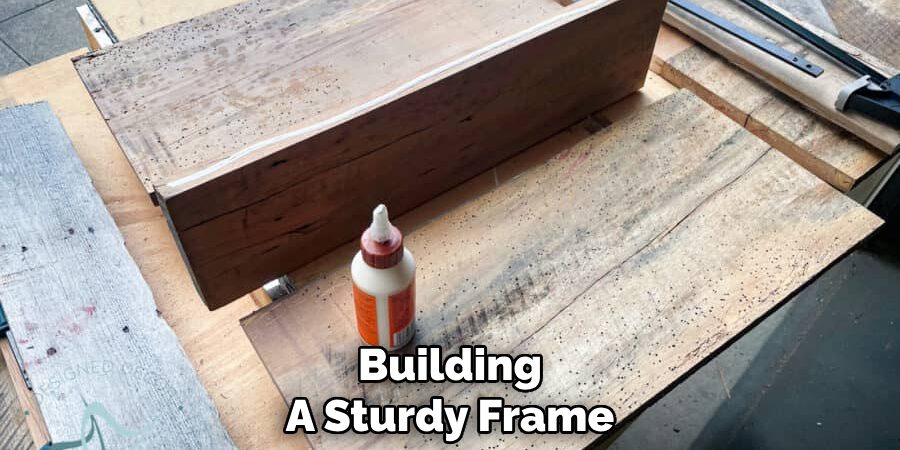
5. Installing a Secure and Functional Door
The cabinet door is essential for protecting the TV while allowing easy access for viewing. A flip-up or bi-fold door is ideal, as it minimizes obstruction when open. Attach the door to the frame using heavy-duty outdoor-rated hinges. To keep the door securely closed when not in use, install a magnetic latch or weatherproof lock. For additional ease of use, consider gas struts or soft-close hinges that prevent sudden slamming. A properly installed door enhances both security and convenience.
6. Ensuring Proper Ventilation
Heat buildup inside the cabinet can damage the TV, making ventilation a crucial aspect of the design. Drill ventilation holes or cut out vents on the sides or back panel to allow air circulation. For improved airflow, install small weatherproof vent covers or mesh screens to keep insects and debris out. If the cabinet is fully enclosed, consider adding a small cooling fan powered by a USB adapter. Proper ventilation prevents overheating and extends the life of your TV.
7. Applying a Weather-Resistant Finish
To protect the wood from moisture, apply an outdoor-grade paint, stain, or sealant. Use UV-resistant and waterproof finishes that can withstand exposure to sunlight and rain. If using composite or PVC materials, choose an exterior paint designed for plastic surfaces. Apply multiple coats for added durability, allowing each coat to dry completely before adding the next. A high-quality finish not only protects the cabinet but also enhances its appearance.
8. Mounting and Securing the Cabinet
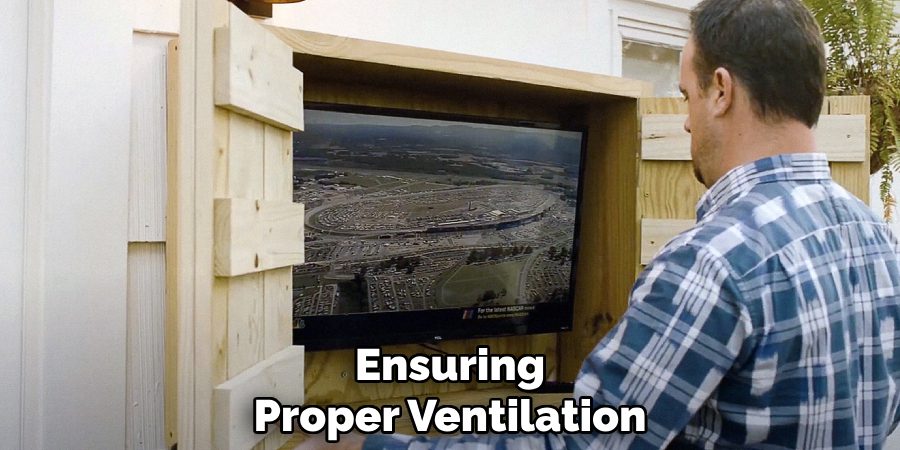
Decide whether the cabinet will be wall-mounted, freestanding, or attached to a post. If mounting on a wall, use heavy-duty brackets or a French cleat system to secure it. Ensure that the mounting hardware is anchored into studs or a solid surface to support the weight of the cabinet and TV. For freestanding units, install a weighted base or secure the cabinet to a deck railing for added stability. Proper mounting ensures that the cabinet stays secure even in windy conditions.
9. Adding Additional Features for Convenience
Enhance the functionality of your outdoor TV cabinet by incorporating useful features. Install a weatherproof power strip inside the cabinet to keep cables organized and protected. Add LED lighting to improve visibility in low-light conditions. If you want extra security, consider installing a lockable latch to prevent unauthorized access. For aesthetic appeal, decorate the cabinet with trim, molding, or outdoor-friendly decals. Customizing the cabinet to fit your needs makes outdoor entertainment more enjoyable.
10. Maintaining the Cabinet for Longevity
Regular maintenance is essential to keep the outdoor TV cabinet in top condition. Inspect the cabinet periodically for signs of wear, such as cracks, peeling paint, or rust on hardware. Reseal or repaint the wood as needed to maintain its weather resistance. Clean ventilation holes and remove dust or debris from inside the cabinet. Check the hinges and locks to ensure they function smoothly. Proper maintenance extends the life of your outdoor TV cabinet, keeping your investment protected.
Things to Consider When Planning Your Outdoor TV Cabinet
Climate and Weather Conditions
Take into account the typical weather in your area, such as heavy rain, strong winds, or extreme temperatures. This will influence the materials and design features you’ll need to ensure the cabinet offers adequate protection for your TV.
Placement and Accessibility
Choose a location that provides some natural shelter, like under a patio roof or pergola, for added protection. Ensure the spot is easily accessible for maintenance and viewing, while also away from direct sunlight to prevent glare on the screen.
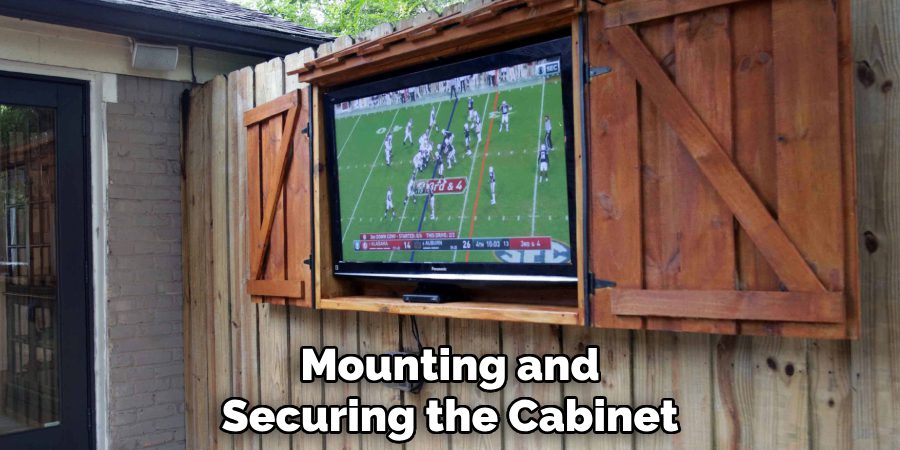
TV Compatibility
Confirm that your TV is suitable for outdoor use or has adequate protection inside the cabinet. If using an indoor TV, ensure the cabinet design accommodates proper insulation without causing overheating or exposure to moisture.
Electrical Setup
Ensure you have access to a weatherproof electrical outlet near the chosen location. Avoid running long extension cords and use outdoor-rated cables to prevent electrical hazards.
Budget and Cost-Efficiency
Balancing quality with cost is essential. Invest in durable materials and protective features without overspending. A well-designed outdoor TV cabinet can save you money in the long term by protecting expensive equipment.
Careful consideration of these factors can prevent potential issues and ensure your outdoor TV cabinet is both functional and durable.
Conclusion
Building an outdoor TV cabinet requires careful planning, durable materials, and weatherproofing techniques to ensure long-lasting protection for your television. By following these ten detailed methods, you can create a sturdy and functional cabinet that enhances your outdoor entertainment space.
From designing a secure frame and sealing the enclosure to installing ventilation and maintaining the cabinet over time, every step plays a crucial role in ensuring durability and performance. Thanks for reading, and we hope this has given you some inspiration on how to build an outdoor tv cabinet!
Professional Focus:
Arden Bernier is dedicated to exploring and advancing patio design and maintenance, combining practical knowledge with innovative solutions. Specializing in outdoor living spaces, he provides expert advice on patio fixes, landscaping, and sustainable outdoor design. With a focus on creating functional, aesthetic, and durable outdoor environments, Arden empowers homeowners to transform their patios into beautiful and relaxing retreats.
Vision:
To inspire and assist homeowners in creating functional, aesthetically pleasing outdoor spaces. Arden encourages creativity and practical problem-solving in patio design, making outdoor living more accessible and enjoyable for everyone.
Education:
- Bachelor of Arts (BA) in Environmental Design – University of California, Berkeley.
- Master of Science (MS) in Landscape Architecture – University of Southern California.
- Specialized training in sustainable landscape design, outdoor space planning, and eco-friendly materials.
Recognition:
- Author at PatioFixes.com, providing expert advice on patio maintenance and design.
- Featured in online platforms and home improvement blogs for valuable tips on patio fixes and outdoor living.
- Recognized for his contributions to making outdoor spaces more eco-friendly and sustainable.
Expertise:
Patio expert with a focus on creating functional, beautiful, and durable outdoor living spaces. Specialization includes:
- Patio design and construction
- Outdoor furniture and décor
- Landscaping and sustainable patio solutions
- Outdoor maintenance and repair techniques
